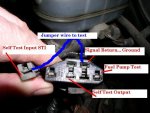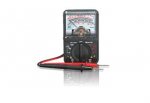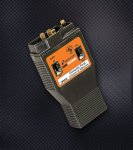It is amazing how easy it is to pull codes yet how difficult it is to do so the first time.
I am in the process of writing a tutorial for how to pull codes, and it looks like my proof reader jumped ship, so I will try to do so with you, and if you would be so kind to help me clarify things that are not clear we can create the perfect easy to read instructional piece for others to follow.
For $20 I expect that you got the bottom of the line actron unit. IT will flash codes (just like your in the dash check engine light will) AND send a sound signal, I guess in case you are an auditory learner. In either case you will have to count flashes or beeps. I will present methods of how to do this without the reader, so that all of the members here may pull codes without having to purchase the same unit as you did.
THere is no doubt that it is a bit confusing, and I am far from an expert, but I should be able to get you to understand it enough that you will be able to do it.
Introduction:
Your engine and transmission are computer controlled.
The computer uses sensors to tell it a number of different things and it controls actuators that push or pull mechanical levers (kinda). If one or more sensors aren't working properly, the computer goes "blind" and doesn't know what to do. If the computer can "see" but one of the actuators is broken and therefore can't follow the commands of the computer; the engine won't run correctly. The computer is preprogrammed with set values for each of its sensors, and each of its actuators. It will run a self check of all systems, like the space shuttle; it will compare its set value(s) to the value(s) it recieves from its sensors, and actuators. If any sensor or acutator is out of the "normal" range the computer will generate a "code." It will generate some codes on the fly, and others will be stored while you are driving. There is a simple method to "pull codes" out of the computer for one to use for diagnostic purposes. The ability to "pull codes" sets mechanics apart from being a troubleshooter or just a parts changer.
Fortunately all it takes to "pull" codes (find out what sensors or actuators are not working) is one piece of wire, a pencil and paper, and the ability to count to ten.
So now.. go out to your truck and locate the plugs you will use to do the self test.
They are located in the engine compartment on the driver's side just above the wheel well, (between the fire wall and the air filter box) it looks like this picture.
Note: in 1985-86 EFI; it is on the "right side" (passenger) behind a black EGR Vacuum Reservoir
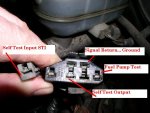
OK now you need a short length of wire. Four inches will do. I put nice little ends on mine (parts I got at radio shack)
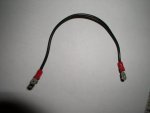
In ten minutes you will shove that wire into the connector, but first you have to check your coolent level and then start your truck and warm her up. In the mean time make sure that you do not have any vacuum leaks.
Checking for vacuum leaks.
Some of the sensors and some of the actuators either read the amount of vacuum, or use vacuum to move controls, therefore it is important to the proper functioning of the engine that your vacuum system is fully intact. Otherwise one may get codes falsely indicating that there is a problem with a controller/actuator, or a sensor when in reality it is caused by a lack of vacuum.
Look at your rubber vacuum hoses (they are about 1/4 - 3/8 inches in diameter, if they are dry rotted or cracked, replace them. IF they slip on/off of their connectors too easily, they may have stretched out a little bit, cut the ends off, and put them back on.
You may listen for a leak. Sometimes using a cut off piece of garden hose is a good aid to listen with. Sometimes a cardboard tube (like from gift wrapping paper) is helpful. Just remember that whenever you stick your head inside a running engine compartment, that you are not wearing any loose clothing or jewelry that can get caught.
Another suggestion is to use a spray can of carb cleaner and spray around the bottom of the intake manifold, and the base of the throttle body assembly. IF there is a leak, you should hear a change in your engine.
OK now that you checked for vacuum leaks your engine should be up to operating temperature.



